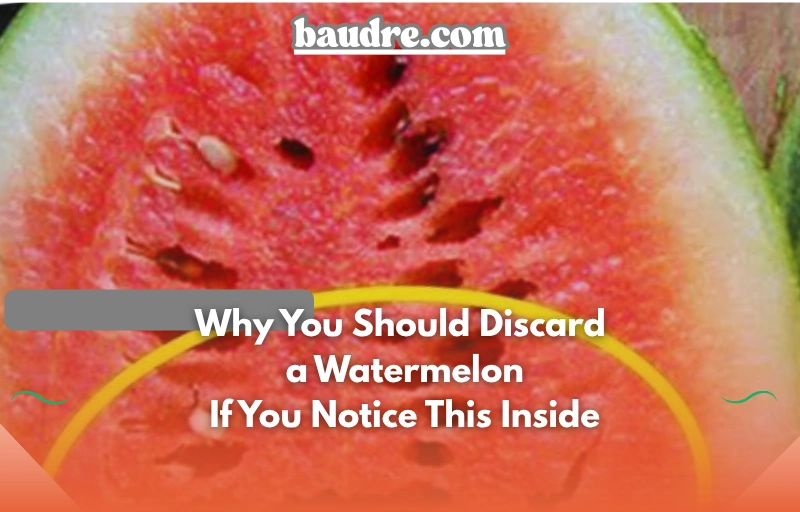A Cautionary Guide to Choosing Safe, Natural Fruit
Watermelon stands out as a summer staple—succulent, thirst-quenching, and packed with nutrients that promote hydration and wellness. With its natural sweetness, it often replaces sugary treats while supplying vital vitamins like A and C. Yet, beneath that vibrant red interior, a warning sign may be hiding—one that could turn your favorite summer snack into a health hazard.

Before you sink your teeth into a slice, there’s something you should be looking for—an indicator that the watermelon might not be as wholesome as it seems.
A Hidden Sign You Should Never Ignore
You might be slicing open a melon and notice long, jagged cracks inside the flesh. At first, it might not seem like anything to worry about. The scent could be pleasant, the exterior unblemished, the color still bright. But these splits, often running deep through the pulp, aren’t merely a cosmetic flaw—they can point to something far more concerning.
What Do These Cracks Really Mean?
Internal fissures or cavities in the flesh of a watermelon may indicate exposure to artificial growth enhancers during cultivation. Specifically, these unnatural divisions are often linked to the use of forchlorfenuron, a synthetic plant growth regulator. This chemical is designed to stimulate faster fruit development and increase size, making the fruit market-ready more quickly.
While some agricultural bodies permit its use under regulatory frameworks, its presence in the food supply raises questions. Cracks appearing inside watermelons are one possible sign that chemical intervention played a role in the fruit’s maturation.
The Potential Risks of Chemical Acceleration
Forchlorfenuron use remains controversial for a reason. Though studies are ongoing, some animal-based research and cellular tests suggest long-term exposure might contribute to potential health issues. Concerns include:
- Possible toxic buildup with repeated consumption
- Cellular damage due to oxidative stress
- Theoretical links to carcinogenic behavior (pending human studies)
When a watermelon displays large, abnormal gaps or textures that seem too soft or slimy—especially when coupled with chemical-like smells or bitter aftertastes—discarding the fruit becomes the wisest choice.
How to Select a Naturally Ripened Watermelon
Avoiding chemically-altered fruit begins at the store or market. Pay attention to these natural indicators of ripeness and quality:
1. The Field Spot
A ripe watermelon usually has a creamy, yellowish patch where it sat on the soil during ripening. The deeper the color, the longer it matured naturally.
2. Heft
Lift it up. A quality watermelon should feel surprisingly heavy for its size, a sign of high water content and freshness.
3. Surface Texture
A firm, unbruised rind with consistent skin tone signals natural ripening. Avoid those with sunken areas or soft patches.
4. Tap for Echo
Knocking on the surface should yield a hollow, resonant thud. A flat sound may suggest it’s under- or overripe.
5. Stripe Contrast
Clear distinction between light and dark green stripes is often a marker of healthy, chemical-free growth.
Proper Storage for Maximum Freshness
Once home, treat your watermelon with care to retain its quality.
Whole Watermelons
Keep in a cool, dry environment if consuming within a day or two. For longer storage, refrigerate to slow deterioration.
Cut Watermelon
After slicing, wrap tightly in plastic or place in sealed containers. Refrigerate immediately and aim to finish within 3–5 days to ensure freshness and flavor.
Final Word: Prioritize Purity Over Appearance
Watermelon offers a bounty of health benefits—from hydration to antioxidant support. It’s rich in lycopene, a compound associated with heart health and reduced inflammation, and delivers a refreshing hit of electrolytes, ideal for hot weather recovery.
However, the nutritional perks only apply when the fruit is safe and untainted. If your watermelon reveals deep internal cavities, or if anything about its appearance, texture, or aroma seems off, err on the side of caution. The risk of ingesting chemically-altered produce isn’t worth the gamble.
Choose wisely, store properly, and when in doubt, toss it out. Let every bite of watermelon be as nourishing and safe as nature intended.
